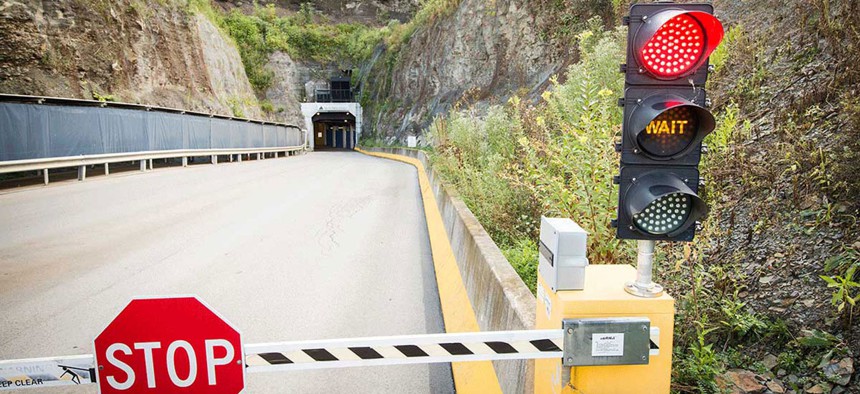An Underground Journey to the Heart of Retirement Processing
A behind-the-scenes look at OPM’s Retirement Operations Center in Boyers, Pennsylvania.
What’s on your bucket list? Some people want to visit the Taj Mahal, float along the canals of Venice in a gondola or hike to the summit of Mt. Kilimanjaro.
All of those experiences sound wonderful, but I also have long had a more mundane item on my list: touring the Retirement Operations Center of the Office of Personnel Management in Boyers, Pennsylvania.
Earlier this month, I got to check that item off my list. I went with a colleague of mine, Joni Montroy of Key Retirement Solutions (who specializes in postal employee retirement issues), to visit the vast underground facility. The tour was led by Ken Zawodny, OPM’s associate director for retirement services; Nicholas Ashenden, deputy associate director for retirement operations at Boyers; and Robert Lorish, deputy assistant director.
We traveled 220 feet beneath the earth’s surface on a golf cart to one of the most secure locations in the country. After we received our security badges, we met our escorts to begin our three-hour visit to a place that we had heard stories about for our entire careers as retirement specialists.
We wanted to see firsthand how retirement claims are processed and find out if the tales we had heard were true. For example, we had been told of a mysterious courier system in which a red truck full of retirement files regularly went from Boyers to Breezewood, Pennsylvania. There it was met by a different red truck that transported the files the rest of the way to Washington. It turned out there is indeed a courier system to transport files that runs several times a week, but it apparently relies on standard trucks, not special red vehicles.
We also learned that the office space is no longer a naturally cool 60 degrees, but has been upgraded with modern HVAC equipment to keep it a comfortable temperature for employees. We could leave our sweaters in the car.
Despite the fact that there were no hidden secrets revealed on our tour, we were fascinated to learn more about what goes on in this cavernous space.
We learned that this is a place where federal employees go to work every day in an office space with rugged walls of blasted limestone that have been painted a bright silver. The floors are lined with 22,000 file cabinets, stacked 10 high and organized into rows, holding 400 million civilian retirement records. Laid end to end, these file cabinets would extend for 26 miles. Stacked on top of each other, they would rise four times higher than Mount Everest.
The history of the processing center dates back to 1902, when U.S. Steel discovered this storehouse of limestone about an hour north of Pittsburgh and began mining it for use in the production of steel. By 1950, mining operations had ceased and the company began using the caverns it had created to protect corporate records. By 1954, space was being rented to businesses and the U.S. government for records storage. In 1960, federal retirement operations moved from the Pension Building (now the National Building Museum) in Washington to Boyers. Today, the space is owned by Iron Mountain, a data and records management company.
In 1960, the facility had 30,000 square feet of dedicated storage space with 42 employees mostly working in jobs related to file storage. Today, there is 221,000 square feet of space with more than 500 employees, now mostly focused on the operational work involved in retirement processing. There are an additional 150 employees who work in the nearby town of East Butler at the OPM call center. Another 300 employees work for Retirement Services at OPM headquarters in Washington.
The workload at the Retirement Operations Center is staggering. Here are a few statistics on its processing activities in fiscal 2018:
- 114,151 retirement claims
- 93,969 survivor claims
- 1,682,983 phone calls
- 251,150 emails
- 84,000 changes of beneficiary designation
- 185,000 pieces of written correspondence
- 4,036,540 Retirement Services Online activities
Retirees can use online services to to update their mailing addresses, change their federal and state income tax withholding designations, request a duplicate annuity booklet or print their Retirement Services ID card. The more retirees and their families turn to online services for basic needs, the quicker the team at Boyers can respond to more complex questions.
On our tour, we learned of many recent changes to improve the efficiency of the tedious process of retirement claims adjudication and responding to various other requests related to retirement benefits. Training sessions were underway in many areas we visited and retirement records were being maintained in an orderly and secure manner.
We returned from our trip with a renewed sense of optimism that federal employees’ retirement benefits are in good hands. Next week, I’ll share what we learned about the step-by-step process of claims processing to help you understand what happens when you transition from a federal employee to a retiree.








